#patapsco river
Text

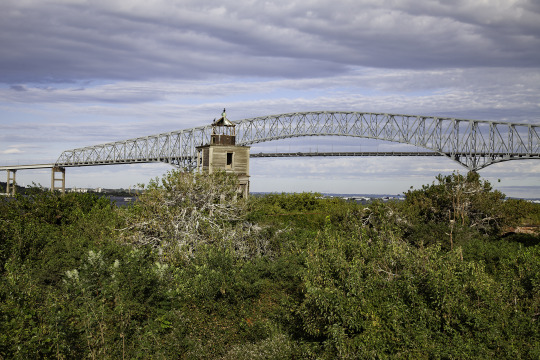




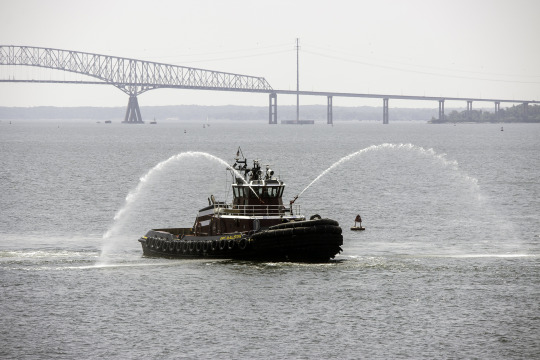

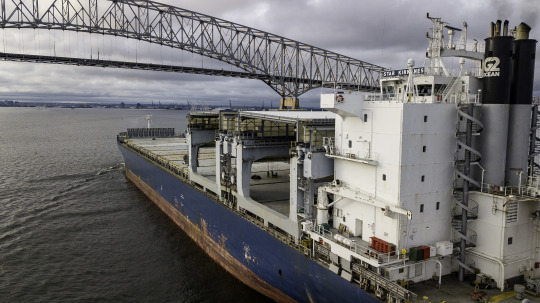

Today in a freak accident a container ship leaving the Port of Baltimore struck a support column for the 1.6 mile long Francis Scott Key Bridge causing enough damage to collapse most of the bridge in seconds.
The skyline of Baltimore City will never look the same again
Francis Scott Key Bridge (1977-2024)
Patapsco River, Baltimore, Maryland
#key bridge#francis scott key#francis scott key bridge#bridge#disaster#baltimore#baltimore city#patapsco river#accident#charm city#bmore
180 notes
·
View notes
Text
Holy shit.
The whole bloody thing is in the water!
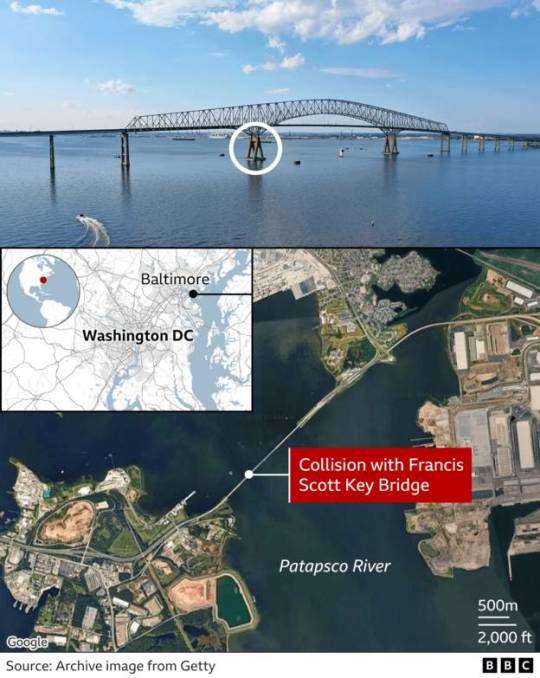
Got hit by a massive container ship.
Fucking hell.
I hope nobody was on the damn thing when it collapsed.
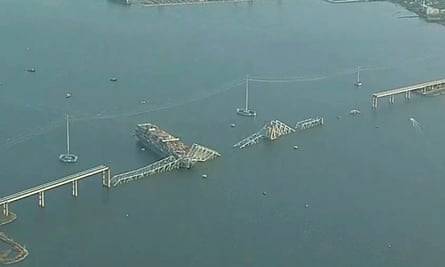
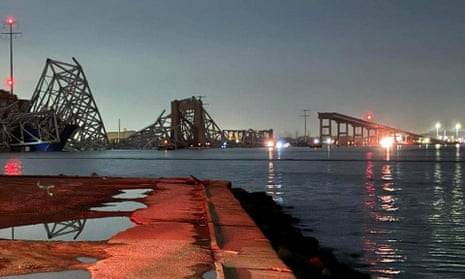

Look at it!

It’s GONE!
Fuck.
What’s that?
They already changed the wording on its Wikipedia page?

Jesus Christ wikipedia!
You fuckers really do work fast!
Oh my GOD!
I’m not trying to sensationalise this btw.
I just wasn’t expecting it.
I’m not anticipating such incidents like some ghastly disaster-worshipping ghoul with issues.
I just hope nobody was hurt or killed.
I also worry that the conspiracy nuts will try saying it was faked or some crap. Fuck that shit!
#dougie rambles#personal stuff#news#maryland#bridge#bridges#bridge collapse#crash#cargo ship#what#fucking hell#wikipedia#Baltimore#river#Francis Scott key bridge#patapsco river#beltway bridge#key bridge#Baltimore harbour#container ship#container shipping#editors#bloody hell#dali#singapore#disaster#shitshow#maersk
105 notes
·
View notes
Text
Fuck I'm So glad we didnt go anywhere this spring break. That bridge is like....so commonly used good lord.
My Cousin uses that bridge (she works at amazon) She took off that day but christ thats such a lucky break.
#Personal#Baltimore#bridge collapse#baltimore bridge collapse#patapsco river#<<<<thats so close to me thats literally my port
3 notes
·
View notes
Text
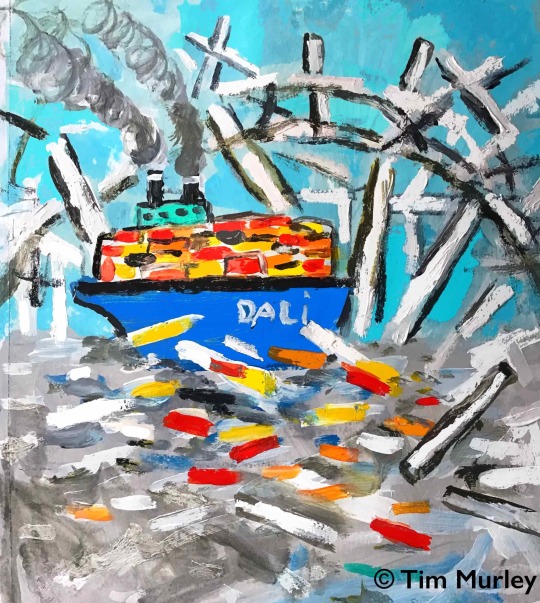
Mayday from the Dali. 🚢 ⚡️🌉🆘🛟🟧🟨🟦🟥
#Baltimore#baltimore maryland#baltimore md#Baltimore bridge#dali#global shipping#shipping container#shipping company#tugboat#pop art#folk art#Francis Scott key#oil and gas#world news#childrens book illustration#construction crew#mayday#sos#big boat#ships#patapsco River#patapsco#cargo ship#super tanker#street art#Francis Scott key bridge#bridge collapse#suspension bridge#contemporary art#basquiat
2 notes
·
View notes
Text

patapsco river
#patapsco river#patapsco#hiking#river#baltimore#maryland#me#mine#pink hair#queer#vanlife#road trip#travel
2 notes
·
View notes
Text

I love the fact that I was looking for something completely different just to find these!

8 notes
·
View notes
Text
youtube
#youtube#militarytraining#Key Bridge#Baltimore#Wreckage Removal#News#Patapsco River#Environmental Impact#Maryland#Infrastructure#Underwater#Progress#Engineering#Update#Demolition#Construction#Recovery#Diving#Salvage#Crane#Project#Machinery#River Cleanup
0 notes
Text
Build Your Bridge Over Troubled Waters
Build Your Bridge Over Troubled Waters
#Unity #BuildingBridges #FrancisScottKey #PoetryCommunity
Image Credit: Pexels
Do we build bridges or walls? I suppose it depends on your planned end result. Human connection works as a bridge, bringing together people built on pillars of education, compassion, understanding, and strength. Disconnection is like demolishing a bridge that can destroy such unity or make people retreat.
When I heard about the huge cargo ship that struck Baltimore’s Francis…
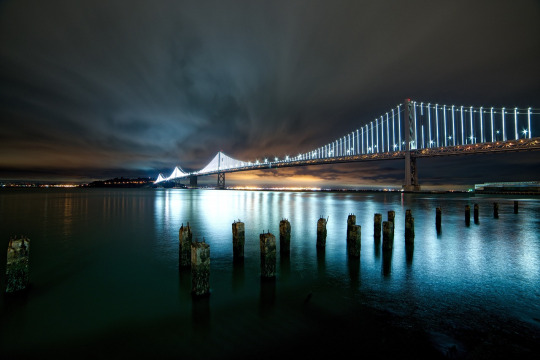
View On WordPress
#Baltimore#Bridge Over Troubled Water#Bridges#Building Bridges#Francis Scott Key Bridge#National Poetry Month#Patapsco River#Poetry#Simon & Garfunkel
1 note
·
View note
Text
New: ‘Heroes’ scrambled to stop traffic before Baltimore bridge collapsed
In the dead of night, a dispatcher’s terse warning pierced the radio waves: a cargo ship, crippled without steering, hurtled towards the Francis Scott Key Bridge. Within moments, officers halted traffic, but their efforts were in vain.
Social Media Links
Follow us on:
Instagram
Threads
Facebook
Twitter
YouTube
DailyMotion
Read More News #latestmalaysia
Baltimore bridge collapsed
The vessel,…
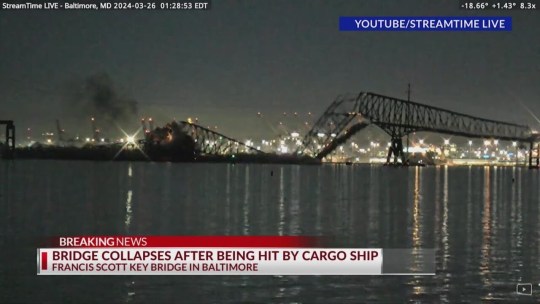
View On WordPress
0 notes
Text
Colapso de ponte na cidade de Baltimore, nos EUA, após colisão de navio
Baltimore, Maryland, EUA – 27 de março de 2024 (CNN) – Uma parte importante de uma ponte em Baltimore, a maior cidade do estado de Maryland, no leste dos Estados Unidos, entrou em colapso após um navio atingir uma de suas colunas.
De acordo com informações da ABC News e de outros veículos de comunicação, a ponte Francis Scott Key sobre o rio Patapsco desabou por volta de 1h30 da manhã desta…

View On WordPress
0 notes
Text
The political climate of Baltimore in 1776

An illustration from 1777 drawn by British printmaker Matthew Darly. It is captioned: “Poor old England endeavoring to reclaim his American children and therefore is England marred and forced to go with a staff.” Courtesy of the Library of Congress.
Baltimore Town was more than a diverse and pre-industrial port town that sat on the Patapsco River. It had numerous sentiments, ranging from the pro-revolutionary, some of which were militant in their beliefs, to support for the British Crown. This article continues the series about Baltimore Town by focusing on the town’s political climate in 1776. You can read our other posts about Baltimore during the Revolutionary War period here.
Reposted this from Academia.edu and my History Hermann WordPress blog. I originally posted this while working at the Maryland State Archives as part of the Finding the Maryland 400 project.
The structures governing the town’s 6,700 inhabitants included a board of commissioners which were handpicked by the general assembly in Annapolis, a development which irked Baltimoreans. [1] This was countered by a powerful alliance between merchants and mechanics on efforts for increased local independence for the town and united in the town’s Whig Club. [2] The Baltimore Whig Club was an organization fanatically dedicated to the revolutionary cause and made up of officers of the First Maryland Regiment, mechanics and merchants. Ultimately, inhabitants of Baltimore Town were allowed to vote for representatives of Baltimore County in the Convention of Maryland. [3] Demands for local independence were so strong that state elites gave the town two seats in the assembly, just like the city of Annapolis. [4]
While Baltimore was a “Whig stronghold” and the First Maryland regiment was also stationed in the town, like Annapolis, there were numerous differences. [5] Annapolis, within the rich Anne Arundel County, had a established planter gentry and served as a huge marketing center for the state’s agriculture. [6] The Revolutionary War gave the merchant community an advantage since it became a distribution center for military supplies, and an armed camp, with troops stationed in the city throughout the war. [7] By 1776, the merchants allied with the British Crown had left or were pushed out, leaving Annapolis to give determined and concentrated support to the revolutionary cause. [8]
Baltimore and Annapolis had a feud which was not healed by 1776. For instance, Baltimoreans were mad that the state assembly perceived them as a backwater village.[9] Relatively, Annapolis had a higher level of affluence than Baltimore and not only were merchants “flush with wartime profits” by the end of the war but the city’s maritime culture prospered. [10] In this commercial and bustling port city, delegates, as part of the Convention of Maryland, met and declared that Marylanders have “no security for their lives or liberties” under the rule of the British Crown. [11]
The Whig Club, which absorbed and represented much of the pro-revolutionary sentiment, was not the only organization with same sentiment in town, or even the first. For example, the Sons of Liberty existed in the town at the same time. [12] As for the Whig Club, its activities ended in April 1777, but it became a manifestation of a new order in Baltimore and set the stage for the post-war environment.
In 1775, the precursor to the club was created by town mechanics. These mechanics were skilled laborers in the clothing, construction, food, and shipbuilding trades. [13] The group was called the Baltimore Mechanical Volunteers. It was the descendant of the Baltimore Mechanical Company, the “closest thing that Baltimore had to representative town government” in the 1760s. [14] The Volunteers was an organization which allowed mechanics to gain confidence in themselves, “their abilities to command and their right to be heard” in the political scene in Baltimore Town. [15]
These Volunteers transformed again as the war progressed forward. In 1775, Baltimoreans proudly organized a Baltimore Mechanical Volunteer Company, a group of militia to defend the town in case of a British invasion, and many of the company’s members were mechanics themselves. [16] This not only politicized the town’s mechanics but the company provided many of the officers who later became part of the Baltimore Whig Club. [17] Later in the war, Baltimorean mechanics also fought as part of the Continental Army.
There were also sentiments favoring the British Crown despite the strong bloc of revolutionary sentiment. Even David McMechen, a member of the town’s Whig Club and a soldier in the First Maryland Regiment, wrote in 1776 that he could not “stay in such a violent place” as Baltimore since he had “too many enemies.” [18]
It is interesting that McMechen said this because in late 1776, supporters of the Crown took up arms after being harassed by the Baltimore Whig Club. [19] British supporters were pushed back until they received support from “the town’s free Negroes who offered protection in their quarters,” and they remained there until they could depart secretly and safely to New York. [20] Still, McMechen could be partially correct. In July 1776, Samuel Purviance, an eminent merchant, wrote that restrictions on trade with Britain were viewed less favorably in Baltimore County, which the town was then part of, than elsewhere. [21]
In the early months of 1777, Baltimore was shaken by disruptions to public order. On January 11, Captain Alexander Furnival complained that his soldiers, including William Grimes, had the “hard duty” of keeping guard in Baltimore Town “over the public Stores,” meaning supplies. [22] As a result, some of the local militia were used to take the place of Furnival’s men. Seven days later, the Baltimore County’s Committee of Observation ordered that the artillery companies commanded by Nathaniel Smith and Alexander Furnival, and William Galbraith’s Company of militia in the Baltimore Town Battallion be put on guard to preserve stability in the town. [23] The Committee gave these companies the duty of ending “all Riots and Tumults within the said County, or Baltimore Town” if necessary. [24] Around this same time, three soldiers of Smith’s Company, two of whom were named David Welsh and a drummer named Harry, searched the house of a wealthy merchant, who favored favoring the British Crown, named Melchior Keener. [25]
In line with the tactics used by militant revolutionaries in the town, the soldiers allegedly came in with muskets and bayonets drawn, searching the house in a “Riotous manner, and were guilty of divers irregularities.” [26] Not long after, the Council of Safety wrote to the Committee, describing the following:
“We are much concerned that we have cause again to trouble you on behalf of Melchior Keener, who hath lately been very ill used as he alleges, by some Soldiers of Capt. Nathl Smith’s Company, and others who came without any authority or war- rant that he knows of, to search his house, and committed divers irregularities, two of the Soldiers were David Welch [or Welsh] and Harry the drummer…the Whig club…had no hand in this riot. We wrote to Capt Smith, and request you would with his assistance inquire into the affair and see that the peace is preserved. If Keener be guilty of any offence, let him be prosecuted according to law…We must observe once for all that mobbing men of doubtful principles is not the way to gain friends to the cause of America…What you tell us of the people framing a petition to Lord Howe and the Riots complained of in Baltimore Town have induced the Council of Safety to pass an order…inclosed to you and to each of the Captains.” [27]
While David Welsh’s name does not reappear in Volume 16, it is likely that he is the same as David Walsh, one of the 74 enlisted men who said they were committed to defending “libertys of the country.” [28]
Keener, president of the Baltimore Mechanical Company before the war, had experienced similar treatment. In the fall of 1776, The Whig Club had branded him a traitor and faced with their threats, Keener fulfilled their demands, returning to the town that December. Keener was not the only one threatened in this blazon manner. In March 1777, William Goddard, a well-off printer who rhetorically battled with the Whig Club, was “forcibly haled out of his own House and taken down the street to Mr. Rusk’s Tavern” by a pro-revolutionary mob. [29] The militia of William Galbraith, who were supposed to stop this, allying themselves with these militant revolutionaries, who were part of the town’s Whig Club.
In this contentious environment in Baltimore, the Continental Congress, still sitting in the town, ordered that signed copies of the Declaration of Independence be printed. These copies were printed by publisher and bookseller Mary Katherine Goddard and distributed across the thirteen colonies. The political climate in Baltimore was undoubtedly lively despite the disappearance of the Whig Club in mid-1777. For example, the mechanics, who had worked with the Whig Club, were forming a “new collective identity.” [30]
As the war continued, Baltimore Town changed with the establishment of a new political order, and gained an important economic position, which situated it well in the postwar environment.
– Burkely Hermann, Maryland Society of the Sons of American Revolution Research Fellow, 2016.
© 2016-2023 Burkely Hermann. All rights reserved.
Notes
[1] Charles G. Steffen, The Mechanics of Baltimore: Workers and Politics in the Age of Revolution, 1763-1812 (Chicago: University of Illinois Press, 1984),4, 10.
[2] Ibid, 11; Paul Kent Walker, ‘Business and commerce in Baltimore on the eve of independence,’ Maryland Historical Magazine Vol. 71, no. 3, fall 1976. pp. 296, 300-301; Tina M. Sheller, ‘Freeman, Servants, and Slaves: Artisans and the craft structure of Revolutionary Baltimore Town,’ American Artisans: Crafting Social Identity, 1750-1830, ed. Howard C. Rock, Paul A. Gilje and Robert Asher (Baltimore: Johns Hopkins University Press, 1995), 22-23.
[3] Robert Purviance, A Narrative of Events Which Occurred in Baltimore Town During the Revolutionary War (Baltimore: Jos. Robinson, 1849), 43.
[4] Steffen, 10-11, 72.
[5] Purviance, 61; Keith Mason, “Localism, Evangelicalism, and Loyalism: The Sources of Discontent in the Revolutionary Chesapeake.” The Journal of Southern History 56, no. 1 (1990): 24.
[6] Alice Hanson Jones. Wealth Estimates for the Southern Colonies About 1770 (Chicago: Annual Meeting of the Organization of American Historians, 1973), 34; Steffen, 9, 122; Edward C. Papenfuse. In Pursuit of Profit: The Annapolis Merchants in the Era of the American Revolution, 1763-1805 (Baltimore: Johns Hopkins University Press, 1975), 6. It is also worth noting that in 1776, there was a large amount of British-held debt in Maryland as Papenfuse notes on pages 40-41.
[7] Papenfuse, 2, 78, 80, 86, 83; Rosemary F. Williams, Maritime Annapolis: A History of Watermen, Sails & Midshipmen (London: The History Press, 2009), 24; Elihu S. Riley, “The Ancient City”: History of Annapolis, in Maryland (Annapolis: Record Printing Office, 1887), 182. On July 10th, six companies of the first regiment of Maryland troops commanded by Col. Smallwood headed up the Chesapeake Bay and were joined by three companies in the same regiment stationed in Baltimore.
[8] Papenfuse, 50-51; Williams, 88; Riley, 165.
[9] Steffen, 10, 24, 60, 63.
[10] Papenfuse, 2.
[11] “A Declaration of the Delegates of Maryland July 6,” July 7, 1776, Maryland Journal Vol. III, issue 135, Baltimore, Maryland, pp. 539.
[12] Steffen, 66.
[13] Ibid, xiii, 14, 27, 95-96, 112, 171. Most of the mechanics were propertyless. Like other laborers, mechanics were divided by class position, with some with more wealth than others.
[14] Ibid, 53-54, 57, 171.
[15] Ibid, 53. It is not known if the mechanics, rejected the “selfish principles of corrupt oligarchy” as strongly as the mechanics in the city of New York in June 1776 as noted in the Address of the Mechanics of New York City (June 14, 1776) to the Colonial Congress Principles and Acts of the Revolution in America (Reprint, ed. Hezekiah Miles, New York: A.S. Barnes & Co. Publishers, 1876), 176. In later years, the Volunteers would be a militia unit that defended Baltimore from British invasion during the War of 1812 as noted by the National Park Service, the Historical Marker Database, and other sources. There were other companies of the same name in the 1820s and 1840s. They also were well-honored enough to be mentioned in laws passed by the General Assembly in 1792, 1793, 1797 along with laws passed in 1758, and in 1768.
[16] Ibid, 61.
[17] Ibid, 61, 63, 66, 69. Apparently, some Baltimoreans went further, taking matters into their own hands, possibly engaging in acts of violence, since they felt “pinned between a tyrannical [British] government abroad and a submissive one” in the state itself.
[18] Dunlap’s Maryland Gazette Annapolis, July 9, 1776 Vol. II, issue LXII, pp. 3. For these reasons and others, there was a new police force, made up of adult males, in Baltimore created around the same time which had night watchpersons to preserve “the good order and peace” (Clinton McCabe. History of the Baltimore Police Department (Baltimore: Allied Printers, 1907), 15-16).
[19] Ronald Hoffman, A Spirit of Dissension: Economics, Politics and the Revolution in Maryland (Baltimore: Johns Hopkins University Press, 1973), 184.
[20] Ibid. John C. Rainbolt adds on page 435 of his “A Note on the Maryland Declaration of Rights and Constitution of 1776” (Maryland Historical Magazine Vol. 66, no. 4 (Winter 1971)) that later on in 1776 the committee pushing for independence removed a section from the Maryland bill of rights which made a declaration against the slave trade, proving that there was greater reception for newer political values than “racial and religious values of the enlightenment.” This was likely influenced by the fact that the Black community on the Eastern Shore, thanks to Dunmore’s Proclamation, allied with those favoring the British Crown, participating in an insurrection that was put down by “organized military force” (Hoffman, 184-185). As Donald Marguand Dozer put it in Portrait of the Free State, “in Baltimore…the Whig Club assumed the authority of government and drove the Tories out of Town” (pp. 259). Other writers claim their were “battles” in Baltimore between the Whig Club and “armed loyalists” but never explain if these battles were ideological or pitched street fights (Robert J. Brugger, Maryland: A Middle Temperament, 1634 – 1980, 123).
[21] Purviance, 61.
[22] Journal and Correspondence of the Maryland Council of Safety, January 1-March 20, 1777 Archives of Maryland Online vol. 16, 40, 41.
[23] Heitman, 340, 505; Journal and Correspondence of the Maryland Council of Safety, January 1-March 20, 1777 Archives of Maryland Online vol. 16, 363, 384; Steffen, 70, 72.
[24] Journal and Correspondence of the Maryland Council of Safety, January 1-March 20, 1777 Archives of Maryland Online vol. 16, 58. By August of that year, there is still discussions of whether supplies can be left in Baltimore Town safely “or removed to the Fort” (Journal and Correspondence of the Maryland Council of Safety, January 1-March 20, 1777 Archives of Maryland Online vol. 16, 325). The worries about security in Baltimore continued to even December 1777 (Journal and Correspondence of the Maryland Council of Safety, January 1-March 20, 1777 Archives of Maryland Online vol. 16, 436).
[25] Steffen, 60, 69.
[26] Journal and Correspondence of the Maryland Council of Safety, January 1-March 20, 1777 Archives of Maryland Online vol. 16, 58.
[27] Journal and Correspondence of the Maryland Council of Safety, January 1-March 20, 1777 Archives of Maryland Online vol. 16, 59, 60.
[28] Journal and Correspondence of the Maryland Council of Safety, January 1-March 20, 1777 Archives of Maryland Online vol. 16, 73, 74. All of these men are asking to be discharged, then re-enlist a second time as long as they receive rations they need, have higher wages, and bounty “given in other Companys.” Later on, Smith said his troops were “troublesome” but he was keeping them in order (Journal and Correspondence of the Maryland Council of Safety, January 1-March 20, 1777 Archives of Maryland Online vol. 16, 139).
[29] Journal and Correspondence of the Maryland Council of Safety, January 1-March 20, 1777 Archives of Maryland Online vol. 16, 89, 190, 225; Steffen, 65, 70-74, 90. The tavern, where Goddard was brought to “stand trial,” was owned by David Rusk who not only was committed to pro-revolutionary sentiment and a member of the Mechanical Company (Steffen, 71-2; George Washington McCreary, The Ancient and Honorable Mechanical Company of Baltimore (Baltimore: Kohn & Polleck, 1901), 25-26). The Whig Club also had meetings in the house of Rusk, who was a member of the club at the time. Goddard bated radicals throughout the war in his newspaper. Due to this environment it isn’t surprising that the Council of Safety said that Scottish prisoners should be removed from Baltimore as soon as possible, that a jailkeeper named Thomas Dewitt was arrested, likely because he was seen as allied with the British Crown, and that there was “an Insurrection in the upper Part of that [Baltimore] County” suppressed, in part, by Andrew Buchanan (Journal and Correspondence of the Maryland Council of Safety, January 1-March 20, 1777 Archives of Maryland Online vol. 16, 229, 231, 246, 272, 388, 389, 390). It is important to note that Goddard is not the same as the Massachusetts printer who has the same name.
[30] Steffen, 70-71, 276. In 1800, the next organization of the mechanics dissolved and they moved into the political arena with candidates (Steffen, 172).
#baltimore md#baltimore#revolutionary war#politics#us history#merchants#patapsco river#british crown
1 note
·
View note
Text
America's Baltimore accident : बाल्टीमोर हादसे में लापता छह लोगों की मृत मान लिया गया, तलाशी अभियान समाप्त, बाइडेन ने दुख जताया
Washington: अमेरिका के मैरीलैंड प्रांत के बाल्टीमोर में पटाप्सको नदी पर बने ऐतिहासिक फ्रांसिस स्कॉट ब्रिज (पुल) से एक मालवाहक जहाज टकरा गया। इसके बाद पलक झपकते ही यह ब्रिज ढह गया।
इस हादसे के दौरान कई लोग और कारें नदी में गिर गईं। इस दौरान लापता छह लोगों की नदी में तलाश की गई। कोई पता न चलने पर आखिरकार उन्हें मृत मान लिया गया है।
द न्यूयॉर्क टाइम्स की रिपोर्ट के अनुसार, अमेरिकी कोस्ट गार्ड ने…
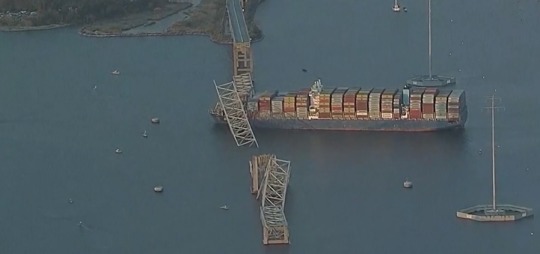
View On WordPress
0 notes
Text
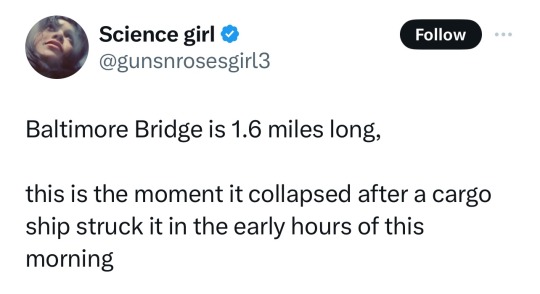

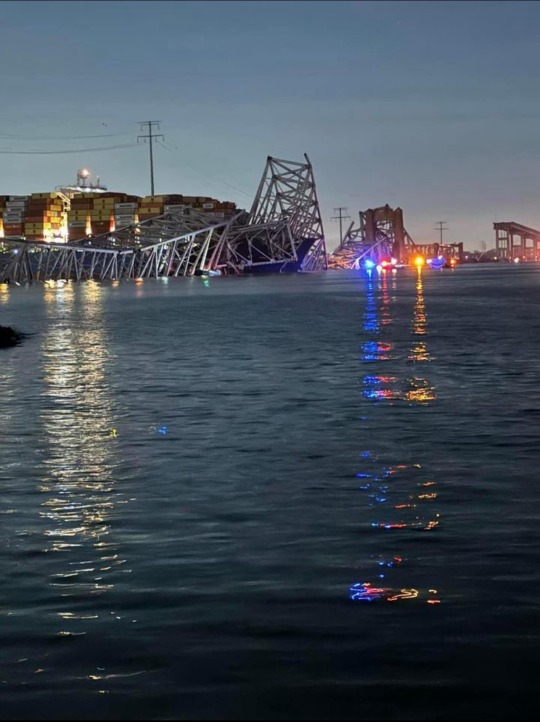
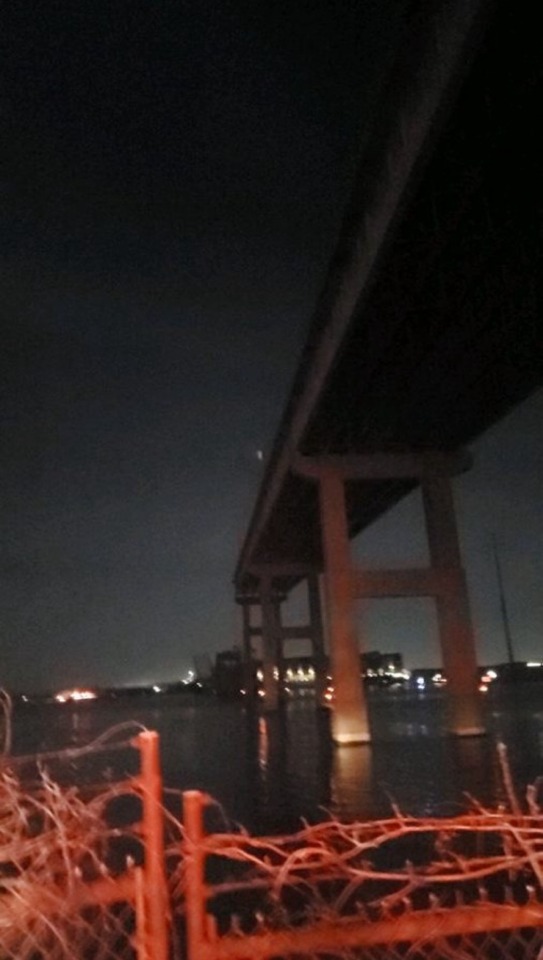
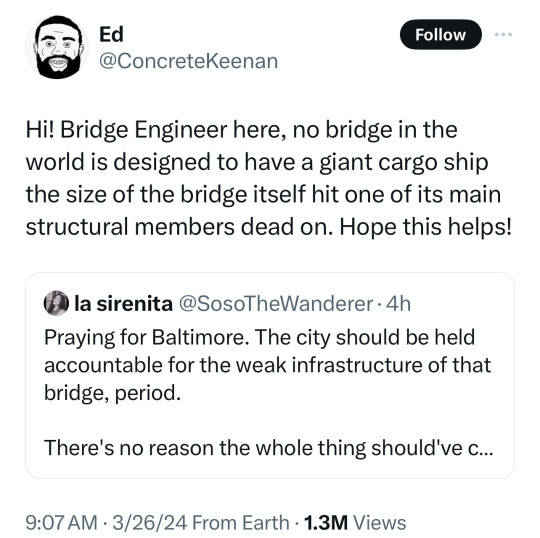

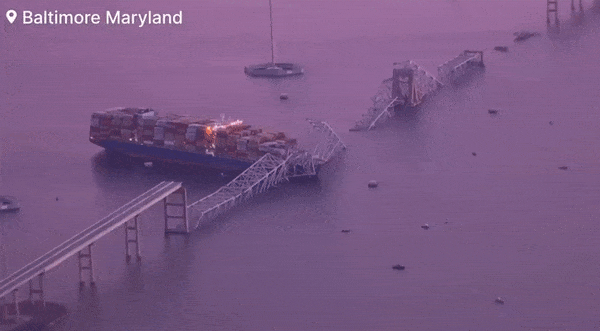


The crew of a massive container ship that crashed into the Francis Scott Key bridge in Baltimore early Tuesday warned of power issues before the collision, which caused the bridge to collapse into the frigid Patapsco River, officials said.
Maryland Gov. Wes Moore said the warning from the ship’s crew likely saved lives.
“We’re thankful that between the mayday and the collapse, that we had officials who were able to begin to stop the flow of traffic so more cars were not on the bridge,” Moore said. He called those officials heroes.
Moore noted that the bridge was up to code at the time of the collapse. He said the collapse was a “shocking and heartbreaking” event for the people of Maryland who have used the bridge for 47 years.
(continue reading)
#i was in dc this weekend for a funeral#we bounced over to baltimore to visit some family friends from childhood#i drove over that bridge twice!!#francis scott key bridge#baltimore#bridge collapse#baltimore bridge#glen burnie#i dont think it was an infrastructure problem#but if oversized cargo ships can gain that much momentum#then maybe they should be required to come to a complete stop#prior to going under a commuter bridge#that or maximum ship size requirements by bridge#or maybe use tugboats??#it seems more like a regulation issue#and yes - even if it was an accident#someone still needs to be held accountable#or it may happen again#a very similar incident happened in my hometown#i think about 4 or 5yrs before i was born#sunshine skyway bridge
4K notes
·
View notes
Text
okay because I'm seeing some misinfo, here's the story on the Key Bridge collapse
What was the Key Bridge?
The Francis Scott Key Bridge (also called the Key Bridge, the Beltway Bridge, and the Outer Harbor Crossing) was steel-arch continuous-through-truss bridge spanning the Patapsco River south of the Baltimore Harbor. The bridge took 5 years to build and cost an estimated $145 million ($735 million in today's dollars). The full bridge project (including approaches) was 10.9 miles long, but the stretch over the Patapsco was 1.6 miles long and 4 lanes wide, and comprised a length of I-695, the Baltimore Beltway. It traveled between Hawkins Point and Dundalk, and in addition to the I-895 Harbor Tunnel was the primary way for Marylanders to cross from the Eastern Shore to the West. The bridge carried an estimated 11.5 million vehicles per year. There is a lane for ships to pass under the Key Bridge with enough clearance.
Was it structurally sound?
The bridge received its latest inspection in 2022 and received a 6/9 score, which is considered "fair" by federal standards. There was a concern with one of its columns, which was downgraded from a health index of 77.8 to 65.9, but it is not clear yet if this was one of the columns struck by the ship. In 1980 the bridge was struck by a different cargo ship which destroyed a concrete support structure, but the bridge itself was unharmed. There is as of yet no evidence that the bridge collapsed because of poor condition. Experts say the lesson to be learned is about the size and weight of modern cargo ships, and that the bridge was not to blame. Engineers have noted, however, that the bridge's piers lacked protective devices such as fenders.
What was the ship?
The MV Dali is a container ship flying the Singapore flag. It is owned by Grace Ocean Private Ltd. and operated by Synergy Marine Group Ltd. The ship is currently being chartered by Maersk, a Dutch shipping company. It was built in 2015 by Hyundai. The ship is 980 feet long and 157 feet wide. The ship's gross tonnage (its internal volume) is 95,128 tons (190,256,000 pounds). Its deadweight (the weight of cargo it can carry) is 116,851 tons (233,702,000 pounds). The ship was carrying 3,000 containers. The engine is a MAN-B&W 9S90ME putting out 41,480 kilowatts (55,626 horsepower).
Over its lifetime the Dali has been inspected 27 times, and only 2 faults were ever found. On June 27, 2023 the Dali was held in port in Chile due to an issue with the propulsion system. According to an inspector the pressure gauges on the heating system were "unreadable". The fault was fixed before the ship left port.
The Dali is crewed by 22 Indian nationals including 2 maritime pilots.
What happened?
The Dali arrived at the Port of Baltimore on March 23, 2024. At 12:44 AM on March 26, 2024 the Dali left port, beginning its journey to Colombo, Sri Lanka. At 01:26 AM the ship suffered a "complete blackout" and began to drift out of the shipping lane. It is not yet known what caused the electrical failure. The backup generator did not power the propulsion system. At around 01:26 AM the crew of the Dali sent a mayday distress call to the Maryland Department of Transportation (MDOT) informing them of the loss of power and that a collision with the Key Bridge was possible. The anchors were dropped as an emergency measure to attempt to slow or stop the vessel. At the request of one of the pilots traffic flow over the bridge was immediately halted. Black smoke was seen coming from the Dali, which experts believe was the result of the crew managing to restart the power system to regain some maneuvering capability.
At 01:28 AM the Dali, traveling at 8 knots (considered to be a fast speed) collided with a support strut beneath the Key Bridge's metal truss at the southwest end of the bridge. A Baltimore resident said he heard the collision and that it "felt like an earthquake". Emergency teams began receiving 911 calls at 01:30 AM, and the Baltimore Police Department were alerted at 01:35 AM. One of the officers present radioed that he was going to go onto the bridge to alert the construction crew as soon as a second officer arrived, but the bridge collapsed seconds later.
What was the damage?
The Key Bridge has completely collapsed. The metal truss relies on structural tension from the bridge itself to maintain its rigidity. As soon as one of the support columns was destroyed, the rest of the bridge quickly followed.
The damage to the Dali is reported as minimal. The ship was impaled by the bridge's structure above the waterline, but has maintained watertight integrity. The crew has not reported any water contamination from its 1.8 million gallons of marine fuel. 13 containers carrying potentially hazardous material were damaged, and are being inspected by a team of Coast Guard divers. At least 5 vehicles including 3 passenger cars and a cement mixer were detected underwater, but authorities do not believe they were occupied
Who was hurt?
The crew of the Dali reports no casualties, except one crewmember who was hospitalized for minor injuries. There was a crew of 8 construction workers on the Key Bridge filling in potholes. 2 were immediately pulled from the water by rescue crews, with 1 being rushed to emergency care and the other reporting minor injuries and refusing treatment. The hospitalized worker has since been discharged. 1 of those rescued was Mexican. The remaining 6 remain missing. Of those 6, 2 have been identified:
Miguel Luna from El Salvador
Maynor Yassir Suazo Sandoval from Honduras
Of the remaining 4, 2 are Guatemalan nationals. Neither have been identified, but the Guatemalan Foreign Affairs Ministry has stated that they were a 26-year-old from San Luis, Petén, and a 35-year-old from Camotán, Chiquimula. The other 2 are presumed to be Mexican.
Rescue Efforts
The Coast Guard was immediately deployed for search-and-rescue operations. Military Blackhawk helicopters were seen over the river. Rescue efforts were ended at 07:30 PM on March 26, 2024 due to darkness, fog, and cold temperatures. Rear Admiral Shannon Gilreath said "Based on the length of time that we've gone in the search, the extensive search efforts that we put into it, the water temperature -- at this point, we do not believe that we're going to find any of these individuals still alive". Recovery operations resumed at 07:30 AM on March 27, 2024 with all 6 workers presumed dead.
No divers have yet entered the water underneath the bridge. Supervisory Special Agent Brian Hudson of the FBI's Underwater Search and Evidence Response Team said "the debris field is pretty sizable and I know that’s why they’re hesitant to send divers down because some of the debris is still shifting, the heavy weight of the rocks". The FBI has deployed Remotely Operated Vehicles (ROVs) equipped with cameras and SONAR.
Aftermath
At 05:08 AM on March 26, 2024 Transportation Secretary Pete Buttegiege posted on X (formerly Twitter):
"I’ve spoken with Gov. Moore and Mayor Scott to offer USDOT’s support following the vessel strike and collapse of the Francis Scott Key bridge. Rescue efforts remain underway and drivers in the Baltimore area should follow local responder guidance on detours and response."
At 07:30 AM on March 27, 2024 President of the Maryland State Senate Bill Ferguson posted on X (formerly Twitter):
"Over 15,000 in the Balt region rely on daily operations at Port of Baltimore to put food on the table. Today, with Del. @LukeClippinger and colleagues representing Port, we are drafting an emergency bill to provide for income replacement for workers impacted by this travesty."
At around 09:40 AM on March 26, 2024 Maryland Governor Wes Moore and Baltimore Mayor Brandon Scott declared a State of Emergency to take effect at 10:30 AM March 26, 2024, and to last 30 days. Baltimore's Emergency Operations Plan was put into effect.
More than 1,000 personnel from the US Army Corps of Engineers (USACE) have been deployed to assist with clearing the debris and rebuilding efforts. President Joe Biden has pledged that the federal government will pay for the entire reconstruction of the bridge.
Jennifer Homendy, the chair of the National Transportation Safety Board (NTSB) has recovered the Dali's data recorder, and will be inspecting both the Key Bridge and the Dali to determine the cause of the crash and the collapse. She says the investigation could take up to 2 years to complete.
Was it intentional?
According to William DelBagno, head of the FBI's Baltimore field office: "There is no specific or credible information to suggest there are ties to terrorism in this incident".
Secretary of Homeland Security Alejandro Mayorkas said: "There are no indications this was an intentional act".
At least 3 people have been killed in accidents related to ships operated by Synergy in the past 6 years. In 2018 a person on board a Synergy ship in Australia was killed in an accident relating to the vessel's personnel elevator. In 2019 an officer aboard a Synergy vessel in Singapore fell overboard while performing maintenance. In 2023 at least one sailor was killed when a Synergy ship collided with a dredging ship in the Philippines. In the first two cases safety inspectors noted that proper safety procedures had not been adhered to.
Sources
1, 2, 3, 4, 5, 6, 7
#atlas entry#this is still a developing story but all the information herein is accurate and current at time of publishing#baltimore#baltimore bridge collapse#francis scott key bridge#key bridge#I spent an hour collating all this info please give it a reblog
2K notes
·
View notes
Text

The Francis Scott Key Bridge in Baltimore, Maryland, collapsed early this morning after it was struck by a large container ship. The 1.6-mile bridge, which crosses the Patapsco River and is part of Interstate 695, broke to pieces and fell into the river below. Several vehicles were plunged into the water; two people have been rescued and crews continue to search for others. An estimated 11.5 million vehicles crossed the bridge annually in recent years.
39.219216°, -76.525551°
Source imagery: WBAL-TV
1K notes
·
View notes
Text
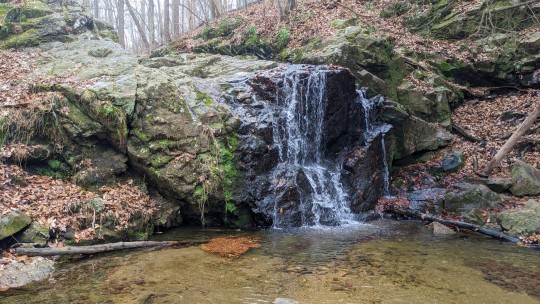
Avalon area; Patapsco State Park 🌳
#patapsco#patapsco river#patapsco state park#baltimore#maryland#waterfall#waterfalls#travel#hiking#camping#vanlife#travel with me
0 notes